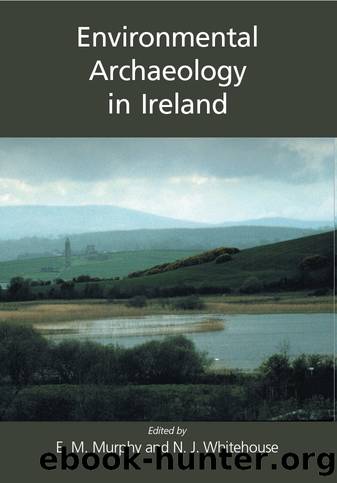Environmental Archaeology in Ireland by Eileen M. Murphy;Nicki J. Whitehouse; & Nicki J. Whitehouse

Author:Eileen M. Murphy;Nicki J. Whitehouse; & Nicki J. Whitehouse
Language: eng
Format: epub
ISBN: 9781782974789
Publisher: Casemate Publishers & Book Distributors, LLC
Published: 2013-08-28T00:00:00+00:00
Rural and Urban Settlement Assemblages
The identification of insects from archaeological deposits has been carried out occasionally since the mid-nineteenth century, but it was only after the publication of Coope and Osborneâs (1968) work on the fauna from the Roman well at Barnsley Park and Osborneâs (1971) study of Roman Alcester that their potential for the investigation of immediate archaeological environments was realised. The technique of looking at archaeological deposits has been most consistently applied at York through the work of Harry Kenward and Paul Buckland. The York results provide the best examples of what can be achieved on a large number of sites by the careful integration of entomological data with other lines of evidence (Buckland et al. 1974; Hall and Kenward 1990; Kenward and Hall 1995). For example, many insect species associated with decomposing matter are weakly to strongly synanthropicâfavoured by, or dependant upon, habitats created by human occupation and activity. Thus, an examination of insects preserved within archaeological deposits can provide a wealth of information about the conditions in which people lived (e.g. Kenward and Hall 1995; Kenward 1999).
In Ireland, there have been a growing number of investigations concerned with the insect fauna associated with urban settlement, particularly from Dublin. Coope (1981) examined two samples from the excavation of an eleventh-century Viking house at Christ Church Place, Dublin. He found an abundance of species which occur in fermenting vegetable refuse, including the synanthropic Aglenus brunneus (Gyll.), which appears to require mould growth associated with decaying organic matter. Many of the taxa would be at home in a building with a thick carpet of fermenting vegetation, which would provide them with acceptable habitats and warmth. Coope suggests that that this squalid, fermenting carpet was perhaps deliberately contrived by the inhabitants to maintain warmth within the building. The fauna is very similar in composition to those found in Viking and Medieval York (cf. Kenward and Hall 1995). In the better preserved floor layers from Viking York, Oslo, and a number of Icelandic and Greenland sites palaeoecological investigations have shown that such floors were frequently covered with a mass of decomposing and fermenting vegetation, carrion and faecal matter and other detritus of life, thereby proving habitats for a wide range of invertebrates (Buckland et al. 1994). These floors may have played a further role, where living on permafrost or perennially frozen ground has a number of disadvantagesâinsulation could have been achieved by allowing the litter to build up (Buckland et al. 1994).
More recently, several urban sites in Dublin have been investigated, including ninth to eleventh century deposits at Essex Street West (Reilly 2003). Here, fossil insect evidence helped to separate the use of the building between an earlier phase when it was used as an animal pen and a later phase when it was used for human occupation. The grain weevil, Sitophilus granarius L. was recovered from a pit from the site, a species which has been recovered from deposits elsewhere in Dublin, dated to the late thirteenth/early fourteenth century and from sixteenth century deposits in Limerick (Reilly 2003, 53).
Download
This site does not store any files on its server. We only index and link to content provided by other sites. Please contact the content providers to delete copyright contents if any and email us, we'll remove relevant links or contents immediately.
| Civilization & Culture | Expeditions & Discoveries |
| Jewish | Maritime History & Piracy |
| Religious | Slavery & Emancipation |
| Women in History |
Cecilia; Or, Memoirs of an Heiress — Volume 1 by Fanny Burney(32067)
Cecilia; Or, Memoirs of an Heiress — Volume 3 by Fanny Burney(31463)
Cecilia; Or, Memoirs of an Heiress — Volume 2 by Fanny Burney(31413)
The Secret History by Donna Tartt(18188)
Sapiens: A Brief History of Humankind by Yuval Noah Harari(13994)
Leonardo da Vinci by Walter Isaacson(12809)
The Radium Girls by Kate Moore(11626)
Sapiens by Yuval Noah Harari(5125)
How Democracies Die by Steven Levitsky & Daniel Ziblatt(4966)
The Wind in My Hair by Masih Alinejad(4849)
Homo Deus: A Brief History of Tomorrow by Yuval Noah Harari(4692)
Endurance: Shackleton's Incredible Voyage by Alfred Lansing(4511)
Man's Search for Meaning by Viktor Frankl(4295)
The Silk Roads by Peter Frankopan(4275)
Millionaire: The Philanderer, Gambler, and Duelist Who Invented Modern Finance by Janet Gleeson(4107)
The Rape of Nanking by Iris Chang(4024)
Hitler in Los Angeles by Steven J. Ross(3803)
The Motorcycle Diaries by Ernesto Che Guevara(3789)
Joan of Arc by Mary Gordon(3788)
